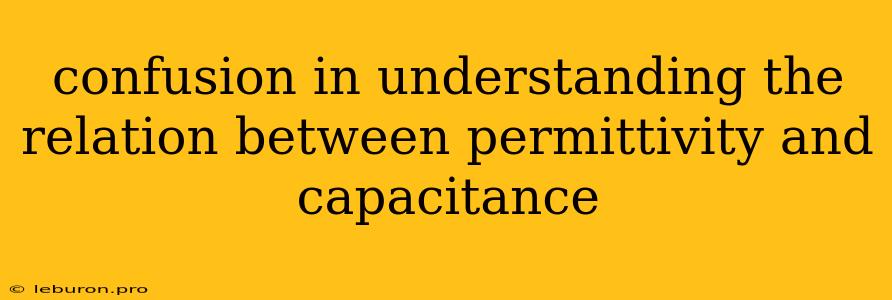Demystifying the Relationship Between Permittivity and Capacitance: A Guide to Understanding their Interplay
Understanding the intricate relationship between permittivity and capacitance is crucial for comprehending the behavior of capacitors, essential components in electronics. While the two may seem distinct concepts, they are intrinsically linked, with permittivity playing a key role in determining the capacitance of a device. This article delves into the intricacies of this relationship, exploring the underlying principles and providing clear explanations to dispel any confusion.
Permittivity: The Ability to Store Electric Energy
Permittivity, denoted by the symbol ε, quantifies a material's ability to store electric energy. It represents the opposition a material offers to the formation of an electric field within it. In simpler terms, a material with high permittivity can store more electric energy within its structure compared to a material with low permittivity.
Types of Permittivity:
-
Relative Permittivity (εr): This dimensionless value compares a material's permittivity to that of a vacuum, which is the reference standard. A relative permittivity of 1 indicates that the material has the same ability to store electric energy as a vacuum. Most materials have relative permittivities greater than 1, signifying their ability to store more energy.
-
Absolute Permittivity (ε): This value represents the permittivity of a material in absolute terms, including the permittivity of free space (ε0), which is approximately 8.85 x 10^-12 F/m.
Capacitance: The Ability to Store Charge
Capacitance, denoted by the symbol C, quantifies a device's ability to store electric charge. It represents the amount of charge a device can store per unit voltage. Capacitance is measured in Farads (F), where 1 Farad is equal to 1 Coulomb of charge stored per 1 Volt.
The Inseparable Bond: How Permittivity Influences Capacitance
The relationship between permittivity and capacitance is fundamental to the operation of capacitors. The permittivity of the dielectric material between the capacitor plates is directly proportional to the capacitance of the capacitor. This means:
-
Higher permittivity leads to higher capacitance: A material with a higher permittivity allows for more electric field lines to be stored within its structure, thus increasing the overall charge storage capacity of the capacitor.
-
Lower permittivity leads to lower capacitance: A material with a lower permittivity offers greater resistance to the formation of an electric field, leading to a lower capacity for charge storage.
Let's illustrate this with a simple example. Imagine two capacitors with identical physical dimensions but different dielectric materials. The capacitor with a dielectric material having a higher relative permittivity will have a higher capacitance than the capacitor with a dielectric material having a lower relative permittivity. This is because the material with the higher permittivity can store more electric energy within its structure, allowing the capacitor to hold more charge at the same voltage.
The Equation That Links Permittivity and Capacitance
The relationship between permittivity and capacitance can be mathematically expressed through the following equation:
C = εA/d
where:
- C is the capacitance
- ε is the permittivity of the dielectric material
- A is the area of the capacitor plates
- d is the distance between the capacitor plates
This equation highlights the direct proportionality between capacitance and permittivity. It also demonstrates that the capacitance of a capacitor is directly proportional to the area of the plates and inversely proportional to the distance between them.
Understanding the Confusion: Permittivity as a Factor in Capacitance
The confusion often arises from the distinct definitions of permittivity and capacitance. Permittivity focuses on a material's ability to store electric energy, while capacitance focuses on a device's ability to store electric charge. However, it is crucial to recognize that the permittivity of the dielectric material is a key factor that ultimately determines the capacitance of a capacitor.
Think of it this way: Permittivity dictates how efficiently a capacitor can store charge. A material with high permittivity can store more electric energy within its structure, enabling the capacitor to store more charge for a given voltage. In contrast, a material with low permittivity limits the amount of electric energy storage, resulting in a lower capacitance value.
Practical Applications: Leveraging the Permittivity-Capacitance Relationship
The relationship between permittivity and capacitance has numerous practical applications. Engineers and designers can utilize this principle to create capacitors with specific capacitance values for various purposes:
-
High-capacitance capacitors: These are used in applications requiring large amounts of charge storage, such as in energy storage devices, filters, and DC-to-DC converters. Materials with high permittivity, such as tantalum oxide, are often employed in these applications.
-
Low-capacitance capacitors: These are used in applications where precise control of charge storage is essential, such as in high-frequency circuits, oscillators, and timing circuits. Materials with lower permittivity, such as air or vacuum, are typically used in these applications.
Conclusion: A Clearer Understanding of the Interplay
By understanding the relationship between permittivity and capacitance, we can better comprehend the behavior of capacitors, essential components in countless electronic devices. The permittivity of the dielectric material is a critical factor that directly influences the capacitance of a capacitor, allowing for precise design and optimization of these components for various applications. By dispelling any confusion surrounding these concepts, we can effectively utilize this knowledge to develop innovative solutions in the field of electronics. The permittivity-capacitance relationship remains a fundamental principle that governs the behavior of capacitors and plays a vital role in the advancement of electronic technology.
